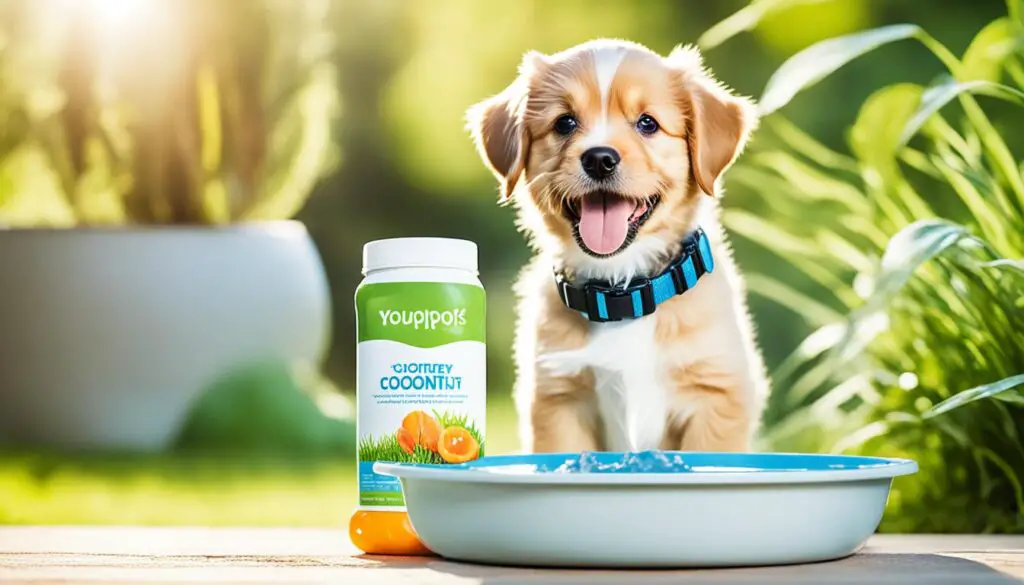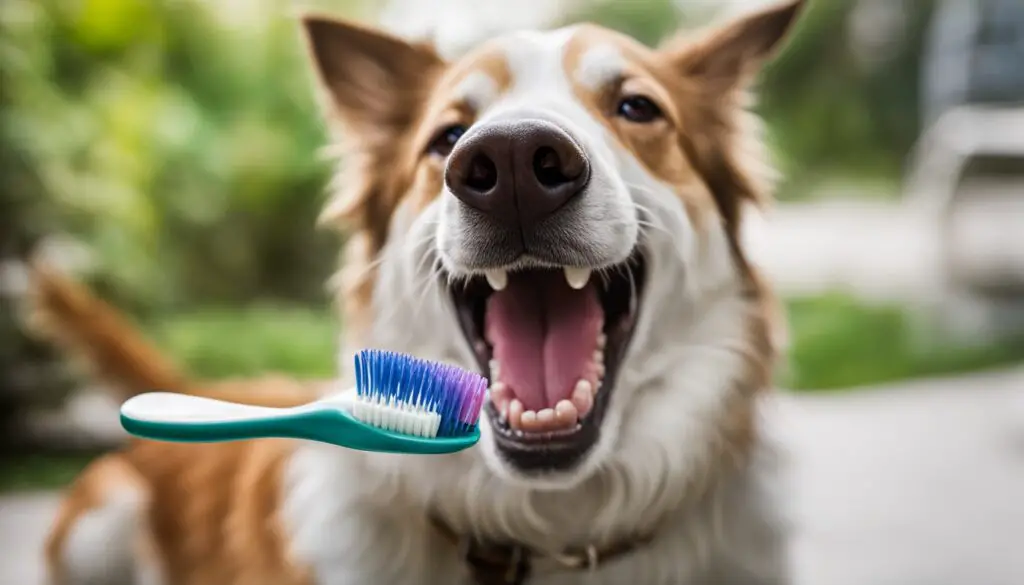Being a good pet owner means making sure our pets are healthy and happy. To do this, we need to take care of their basic needs. This includes watching what they eat and drink, grooming, and visits to the vet. I’ll give you some key insights into pet health and ways to keep your dog happy and thriving.
Key Takeaways:
- Meeting your pet’s basic needs, such as nutritious food, clean water, proper bedding, and toys, is crucial for their overall health and well-being.
- Regular veterinary care, including check-ups, vaccinations, and preventive measures like flea and tick prevention, plays a significant role in maintaining your pet’s health.
- Exercise and mental stimulation are important for keeping your pet physically and mentally healthy.
- Creating a safe environment for your pet and implementing training and bonding activities can strengthen your relationship and ensure their well-being.
- Seasonal care tips, including protecting against extreme weather conditions and implementing parasite prevention measures, are essential for your pet’s health and comfort throughout the year.
Meeting Your Pet’s Basic Needs
It’s very important to meet your pet’s basic needs for their health and happiness. As a pet owner, this is a big part of your job. Make sure they get:
- Nutritious food: Give your pet food that meets their diet needs. Always check with a vet to pick the right food.
- Access to clean water: Keep water fresh for your pet all the time. This helps keeps them healthy.
- Treats: You can give your pet treats for good behavior or training. Just watch the portion sizes and pick healthy treats.
- Toys: Toys are not just fun, they keep your pet’s mind and body active. This is key to prevent boredom and stay fit.
- Comfortable bedding: Your pet should have a soft and safe spot to sleep. It’s important for their comfort and health.
- Veterinary visit: Don’t forget regular vet check-ups. Your vet can help keep your pet healthy and give you advice.
- Food and portion control: It’s vital to manage how much your pet eats. This helps prevent them from becoming overweight.
- Grooming routines: Pet grooming includes things like baths, brushing, and preventing fleas. This keeps them clean and healthy.
- Nail trimming: Make sure to cut your pet’s nails often to avoid discomfort or injury.
Keep in mind, looking after your pet’s basic needs means you’re a responsible owner. It supports their health, happiness, and general well-being.
| Basic Needs | Why it’s Important |
|---|---|
| Nutritious food | Provides essential nutrients and energy for growth and overall health. |
| Access to clean water | Prevents dehydration and supports proper organ function. |
| Treats | Can be used for training and rewards, promoting positive behavior. |
| Toys | Mental and physical stimulation, preventing boredom and destructive behavior. |
| Comfortable bedding | Provides a safe and cozy space for your pet to rest and sleep. |
| Veterinary visit | Ensures preventive care, early detection of health issues, and professional guidance. |
| Food and portion control | Prevents obesity and promotes a healthy weight. |
| Grooming routines | Keeps your pet clean, prevents matting, and removes fleas or ticks. |
| Nail trimming | Prevents injuries and maintains proper foot health. |
Maintaining Your Pet’s Health with Routine Care
Routine care is really important for your pet’s health and well-being. It helps you catch any health issues early and stops them from getting sick in the first place.
Vet Check-ups
It’s vital to bring your pet in for regular vet visits. These check-ups can catch health problems before they get worse. Vaccines and a full health check are key parts of these visits.
Your vet will check your pet’s weight, temperature, and more. Vaccines protect your pet from diseases and keep their immune system strong.
Flea and Tick Prevention
Fleas and ticks can make your pet really uncomfortable and spread diseases. It’s crucial to use prevention methods to keep your pet safe. Your vet can help you choose the best prevention method based on your pet’s lifestyle.
Vaccinations
Vaccines are very important for your pet’s health. They protect your pet against serious diseases. Make sure your pet stays up to date on their shots.
Your vet will set a vaccine schedule based on your pet’s needs. It’s essential to have some talks with your vet to decide on the best vaccination plan.
Spaying or Neutering
Having your pet spayed or neutered has a lot of health benefits. It also helps control the pet population. This surgery can lower the risk of health problems and make your pet’s behavior better.
Your vet can advise you on the best time to spay or neuter your pet.
Dental Care
Dental care is vital for your pet’s health. Bad teeth can cause many serious health issues. Regular teeth cleanings and proper care can keep your pet’s mouth and body healthy. Your vet will guide you on the best dental care for your pet.
Regular care, including check-ups, flea and tick prevention, vaccinations, spaying or neutering, and dental care, is key to your pet’s good health and happiness.
| Routine Care | Benefits |
|---|---|
| Vet Check-ups | Early detection of health issues Preventive care and vaccinations |
| Flea and Tick Prevention | Protection against parasites Prevention of diseases |
| Vaccinations | Prevention of common diseases Boosting the immune system |
| Spaying or Neutering | Reduction of certain health risks Control of pet population |
| Dental Care | Maintaining oral health Prevention of dental diseases |
Exercise and Stimulation for a Healthy Pet
Keeping your pet active and engaged is crucial for their health. Exercise helps with their bones, muscles, and prevents obesity. It’s also good for their heart and lungs. Mental activities keep them thinking and prevent boredom.
Walking is a great way to exercise your pet. It lets them see and smell new things. Try to walk your pet for a least 30 minutes every day. But, adjust this based on their age, kind, and how fit they are.
Playing fetch is fun for you and your pet. It makes them move and think quickly. A good ball or frisbee can lead to a lot of fun times together.
Puzzle and interactive toys are great for mental exercise. They make your pet think to get a reward, like finding a hidden treat. Many different puzzle toys are available, keeping your pet entertained for hours.
“Slow-pace mealtime can also provide mental stimulation for your pet.”
Even mealtime can be made more engaging. You can use puzzle feeders or a tennis ball in their bowl. This makes your pet work a little to eat, which can be fun for them.
Each pet is different, so find what works best for yours. Older pets might need lighter activities. High-energy pets could use extra workouts. Always check with your vet for the best plan.
Benefits of Exercise and Stimulation:
- Improved cardiovascular health
- Stronger muscles and joints
- Weight management and prevention of obesity
- Reduction in destructive behaviors caused by boredom
- Promotes mental sharpness and focus
- Enhanced bond between you and your pet
Tips for Exercise and Stimulation:
- Start slow and gradually increase the intensity and duration of exercise.
- Choose activities based on your pet’s age, breed, and energy level.
- Make exercise a fun and enjoyable experience for both you and your pet.
- Provide a variety of toys and puzzles to keep your pet mentally stimulated.
- Set aside dedicated playtime each day to bond and engage with your pet.
| Exercise Options | Benefits |
|---|---|
| Walking |
|
| Playing Fetch |
|
| Puzzle Toys |
|
| Slow-Pace Mealtime |
|
Keeping Your Pet Safe
Keeping your pet safe is of the utmost importance. A few simple steps can make a big difference. For starters, it’s key to register your pet and to ensure your home is a safe space. These actions will help keep your beloved friend safe and happy.
Pet Registration and Microchipping
First off, be sure to register your pet with the local authorities. This step is not just about following the law. It’s also crucial for finding your pet if they ever get lost. Furthermore, microchipping your pet is a good move. With a microchip under their skin, finding a lost pet is much easier.
Securing Household Hazards
Our homes can hide many dangers for our pets. Things like electrical cords, medicines, and cleaning products can harm them. Make sure these items are unreachable. This is a simple but effective way to protect your pet.
Creating a Safe Space
Think about stressful times for your pet, like storms or parties. A dedicated space with their favorite things can comfort them. Include their toys, soft bedding, and a quiet area. This can help them feel safe and secure.
Cleaning Your Pet’s Belongings
Don’t forget to clean your pet’s stuff routinely. Things like toys, blankets, and bedding can easily gather germs. Clean them with pet-safe soap and make sure they are dry before using them again. This simple task keeps your pet healthy.
Keeping Food Out of Reach
Not all human foods are safe for pets to eat. Chocolate, grapes, and certain nuts are just a few dangers. To avoid accidents, keep these foods far from your pet. Understanding what is toxic is key to their safety.
Using a Leash
Outdoors, a leash is a must for your pet. It helps keep them safe. Even well-trained pets can run into trouble. With a leash, you protect them from harm and ensure good behavior around others.
| Safety Measure | Description |
|---|---|
| Pet Registration | Register your pet with local authorities to comply with pet laws and aid in identification if they get lost. |
| Microchipping | Implant a microchip under your pet’s skin to increase the chances of finding them if they go missing. |
| Securing Household Hazards | Identify and safely secure potential hazards in your home, such as electrical cords, medications, and cleaning chemicals. |
| Creating a Safe Space | Set up a comfortable area within your home where your pet can retreat during stressful situations. |
| Cleaning Your Pet’s Belongings | Regularly wash your pet’s toys, blankets, and bedding to remove germs and allergens. |
| Keeping Food Out of Reach | Store human foods that are toxic to pets in secure locations to prevent accidental ingestion. |
| Using a Leash | Keep your pet on a leash in public places to prevent accidents, injuries, and conflicts with other animals. |
Training and Bonding for a Strong Relationship
Training your pet is key to a strong bond and harmony. It ensures good behavior and a close relationship with your pet. Through training, you and your furry friend will communicate well, respect each other, and work together.
Spending time alone with your pet is very important. This can be through petting, playing, or giving them treats. It deepens your connection. Such moments build trust and set the stage for effective training.
Patience is crucial in training your pet. Remember, each pet learns at its own pace. Stay calm and avoid getting upset if they don’t learn a command quickly. It’s also important to be consistent. This helps your pet know what you expect and reinforces their learning.
Positive reinforcement is a great way to train your pet. You use treats or praise to reward good behavior. This method boosts their confidence and makes training fun. It fosters a strong, positive relationship between you and your pet.
Respecting your pet is key. It’s vital to know their comfort levels and individuality. Understanding their needs helps make training a pleasure for you both.
Effective communication is also vital during training. Use the same verbal commands, signals, and body language every time. This will help your pet understand you better, which leads to quicker learning.
Through training and bonding, you and your pet form a strong, cooperative relationship. This is based on trust, respect, and understanding. A well-trained pet not only brings joy but also peace at home.
“Training a pet is not just about teaching them commands; it’s about building a foundation of trust, respect, and cooperation.” – Pet Trainer
Tips for Effective Training and Bonding:
- Schedule regular training sessions to ensure consistency.
- Use positive reinforcement, such as treats and praise, to reward desired behaviors.
- Remain patient and avoid punishment-based training methods.
- Set realistic goals and break them down into achievable steps.
- Be consistent with your cues and commands.
- Keep training sessions short and engaging to maintain your pet’s interest and focus.
- Seek professional help or enroll in training classes if needed.
| Benefits of Training and Bonding: | Why it Matters: |
|---|---|
| Improved behavior | Ensures a well-behaved pet that can follow commands and live harmoniously with you and others. |
| Strengthened bond | Creates a deeper emotional connection and understanding between you and your pet. |
| Enhanced communication | Improves your ability to communicate effectively with your pet, leading to better cooperation and understanding. |
| Increased trust and respect | Establishes a foundation of trust and respect, strengthening your relationship and promoting mutual respect. |
| Increased safety | Enables you to guide your pet away from potential dangers and respond to commands or cues in critical situations. |
Seasonal Care Tips for Your Pet’s Health
Different seasons need different care for your pet to stay healthy and happy. As a good pet owner, knowing about weather changes is vital. This helps keep your pet safe and cozy all year.
Summer Safety
In summer, it’s vital to watch your pet’s outdoor time, especially in the heat. Keep them cool with shade and lots of water. Protect their feet from hot surfaces to avoid burns. Ensuring their time outside is controlled and keeping their feet safe helps a lot. If your pet has little fur or bald spots, pet-safe sunscreen shields them from the sun’s harm.
Winter Safety
Winter brings cold dangers your pet must avoid. Aim to keep your pet inside when it’s icy. Dress them warmly with sweaters or booties for extra comfort. Remember to look out for antifreeze, which can hurt your pet. Wiping their paws after walks keeps them from eating bad stuff.
Year-round Parasite Prevention
Stopping parasites all year is key for your pet’s health. This means controlling fleas and ticks to dodge diseases. It also involves heartworm protection since these bugs can kill pets. Talk to your vet to pick the best defense for your pet’s unique needs and area threats.
“By following seasonal care tips, you can ensure that your pet remains safe and comfortable throughout the year.”
| Season | Tips |
|---|---|
| Summer |
|
| Winter |
|
| Year-round |
|
Monitoring Your Pet’s Health and Seeking Veterinary Care
Being a good pet owner means checking on your pet’s health often. Watch for signs like a change in eating or acting oddly. Discharge from their eyes or nose might signal trouble. Also, don’t overlook dental issues like bleeding gums or a smelly mouth.
If your pet shows any of these signs, get help from a vet quickly. They can find the problem and start treatment. Acting fast really helps your pet’s health and life quality.
For emergencies like eating something bad or getting hurt, don’t wait. Call your vet or an emergency clinic right away. Their fast, expert care could save your pet.
FAQ
What are the basic needs of a pet?
Pets need nutritious food and clean water. They also need appropriate treats and toys for fun. A comfy bed is vital too.
How often should I take my pet to the vet?
Regular vet visits keep your pet healthy. Your veterinarian will advise on the right amount based on your pet’s age and health.
What preventive measures should I take for my pet’s health?
Preventing diseases and unwanted litters is key. Measures include flea preventatives, vaccinations, and spaying or neutering.
How can I maintain my pet’s dental health?
Dental health is crucial for pets. Brushing teeth and having regular cleanings help prevent diseases and aid in organ health.
How much exercise does my pet need?
All pets need exercise for their health. The needed amount varies for each pet. Your vet can help determine what’s best for your furry friend.
How can I keep my pet safe?
Ensure their safety by having them registered locally and possibly microchipped. Eliminate hazards at home, create a secure spot, and use a leash outside. Keep toxic things away from them.
How can I train my pet and strengthen our bond?
Use positive training for well-behaved pets. Spending quality time together through play, affection, and treats deepens your bond.
What seasonal care tips should I follow for my pet?
Adjust care per season. In summer, provide shade and water. Winter requires keeping your pet warm and inside. Parasite prevention should happen year-round.
What signs should I watch for to monitor my pet’s health?
Watch for behavior changes, eating habits, and physical signs like discharge. These can signal health problems. Regular dental checks are essential.



